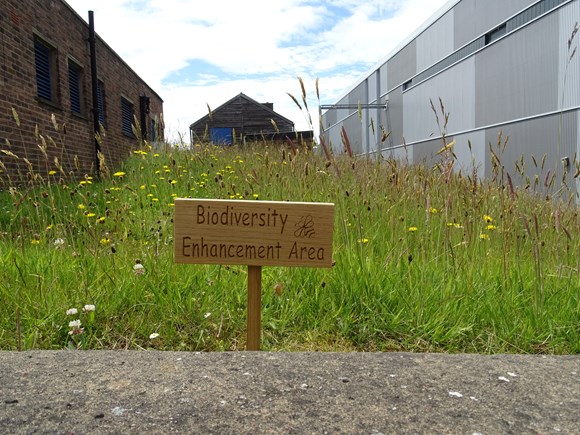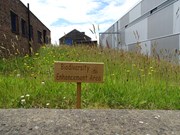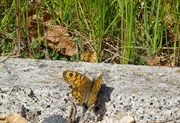
12 Jan 2022
LATEST NEWS: New approach to greenspace management in the Capital leads to butterfly havens

Changes to the management of grassy areas in Edinburgh are helping butterflies cope with the impacts of climate change.
As the climate warms, more species are able to move north into new areas that were previously too cold for them, but they still need the right habitat to survive. For three species – the Small Skipper, Wall Brown and Speckled Wood butterflies – areas of long grass are just what they need. Caterpillars of all three species feed on these grasses, but they are easily wiped out if the grass is cut too often.
Initiatives from the City of Edinburgh Council and other partners in the Edinburgh Living Landscape programme, which is led by the Scottish Wildlife Trust, have helped these species move into the city, and have even given them a stepping stone into south Fife where all three are now being seen for the first time.
The Council has helped by naturalising 264 acres of amenity grassland, which only get cut at the end of summer, through Edinburgh Living Landscape’s Nature in your Neighbourhood project and by sowing wildflower meadows. These are changes which boost populations of bees and other pollinators. With more insects around, animals like birds and bats will also benefit from the changes.
One of the most striking examples has been at Silverknowes Park on Muirhouse Parkway, which is now home to 14 different species of butterfly. This tiny park has been worked on by Council staff and volunteers from Butterfly Conservation through the Helping Hands for Butterflies Project for a few years now, and the list of species there keeps growing. The most recent finds were of Small Skippers, a species that only arrived in Edinburgh four years ago. This species only lays its eggs on the flower stems of tall grasses, so the habitat at the park is perfect for them now.
Projects to create and maintain wildflower meadows throughout the city have helped encourage the spread of these butterflies. At the nearby National Museums Collections Centre in Granton, staff have brought about changes to the management of the site that have seen numbers of butterflies and moths increase dramatically in just two years. Further along the coast, work through the Edinburgh Shoreline project is helping to create yet more coastal grassland.
All of these projects work to create a series of stepping-stones that help butterflies and other insects move through our urban landscape and on into new areas in the countryside. This was demonstrated by the fact that the first sightings of the Small Skipper and Speckled Wood in south Fife were around North Queensferry, and Wall Brown butterflies have been seen near Dalgety Bay.
Climate change is one of the greatest threats to nature and connecting habitats is more important than ever to allow wildlife to respond to changing temperatures.
The City of Edinburgh Council’s Culture and Communities Convener Donald Wilson said:
We’re very proud of our parks and greenspaces and our Biodiversity Action Plan is designed to help us enhance their quality and natural heritage. Under the strategy we’ve undertaken many projects to open up our environment to nature and provide a welcoming habitat for a wide variety of plants, birds and insects, including encouraging native wildlife to urban settings and allowing the public to reap the benefits and get involved.
It’s a sign of success that these areas are now home to these new species of butterflies. These beautiful insects are not only an indicator of the health of our environment in the Capital, they are essential as pollinators and food for other species.
Culture and Communities Vice Convener and Thriving Greenspaces Champion Amy McNeese-Mechan said:
This is a fantastic new approach which ensures that these beautiful insects are at home in the Capital.
Working collaboratively with partners like Butterfly Conservation through the Helping Hands for Butterflies Project and community involvement are key components of our strategy. Together we will work to raise awareness of the rich biodiversity in Edinburgh, enable others to take positive action to protect and enhance our natural environment, and influence other plans, policies and strategies relating to Edinburgh’s open spaces.
Anthony McCluskey, Project Officer with Butterfly Conservation said:
Some butterfly species move quickly in response to climate change, so the spread of so many new species in Scotland shows us how much change there has been already. Initiatives like this to provide more land for them to breed can help populations move through the landscape, helping to secure their long-term future.
Dr Cathleen Thomas, Living Landscapes Programme Manager, Scottish Wildlife Trust said:
It’s really encouraging to see how quickly these butterflies have colonised the city thanks to the new habitat that Edinburgh Living Landscape partners have created.
This is a great example of how creating new green networks in Edinburgh can help tackle the climate and nature crisis by helping wildlife adapt to change.
Contact Information
Karen Jamieson
Karen.Jamieson@edinburgh.gov.uk
Notes to editors
Edinburgh Living Landscape is a long-term vision to increase the quality of the city’s urban environment. This will benefit wildlife and increase the quality of ‘natural services’ including improved air quality, flood prevention, and increased encounters with nature.
The project will reinforce and expand existing green networks and connect the people of Edinburgh to their natural environment. Edinburgh Living Landscape will work to benefit local people and wildlife with an aim to make the city one of the most sustainable in Europe by 2050.
Edinburgh Living Landscape is about working with and connecting green infrastructure at multiple scales, from window boxes, green roofs, street trees through to large parks and urban woodlands within the cityscape, and about making the links between a healthy environment, a healthy economy, people’s wellbeing and ultimately the prosperity of Edinburgh.
Edinburgh Living Landscape is a partnership project between the Scottish Wildlife Trust, Butterfly Conservation Scotland, City of Edinburgh Council, Edinburgh and Lothians Greenspace Trust, NatureScot, Royal Botanic Garden Edinburgh, RSPB Scotland and the University of Edinburgh.


